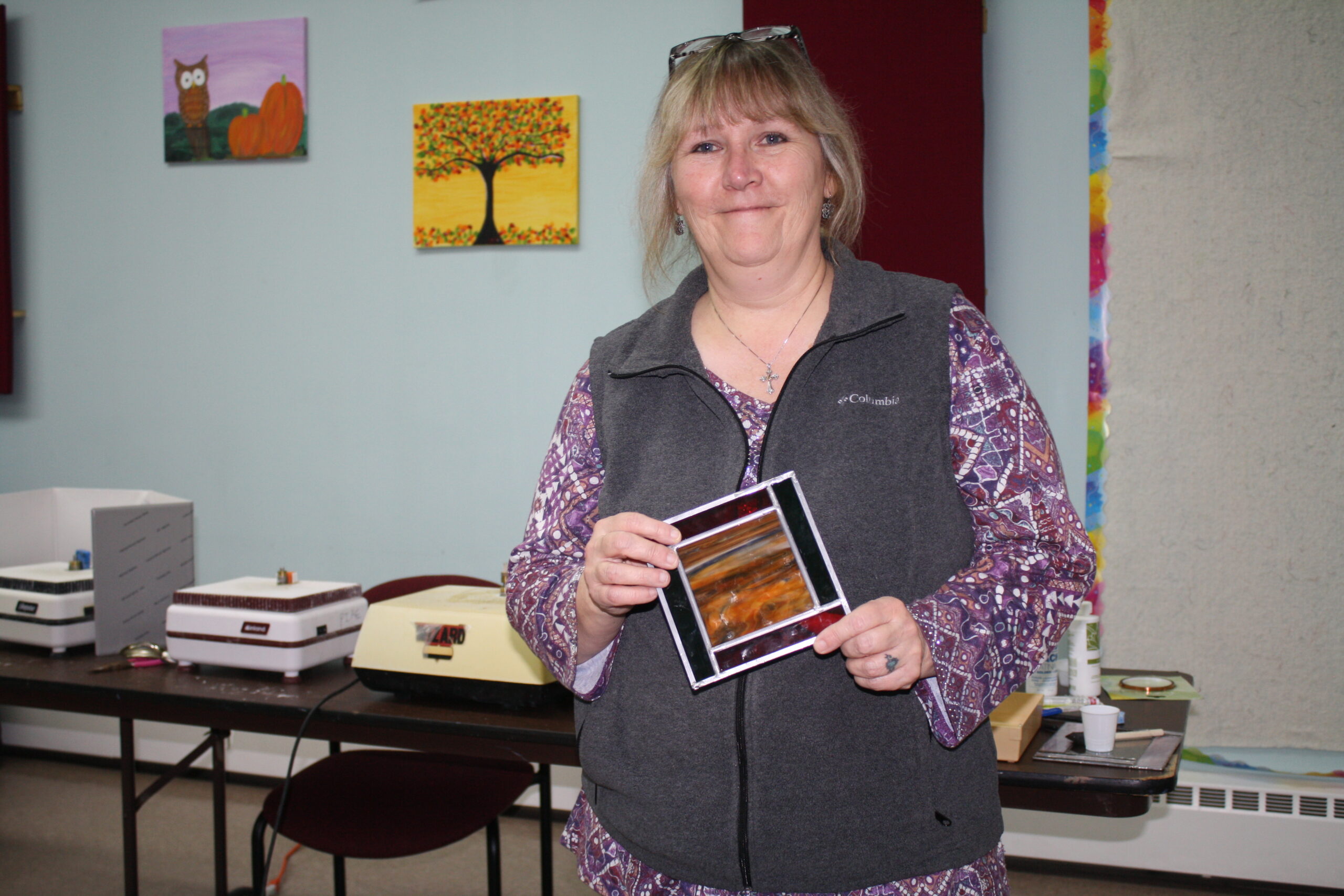
PRESQUE ISLE, Maine — Have you ever wondered how to create jewelry, window catchers or other unique home decorations that are as beautiful as stained glass windows? Crafters need to look no further than stained glass itself.

Amber Jeskey, left, of Limestone, and Koralie Emerson of Fort Fairfield embark on the first steps of glass making during a class taught by Lisa Wark at the Skyway Education Center in Presque Isle on March 14. (Melissa Lizotte)
Like any craft, stained glass techniques can be challenging to learn at first. But with the right guidance and tools, folks can use their talents toward a new and exciting hobby that they can easily do right at home.
Lisa Wark of Mapleton has taught beginner and advanced stained glass courses for several years now through the SAD 1 Adult and Community Education program and the SAD 32 Adult Education program in Ashland. She recently started a spring beginner course at SAD 1’s Skyway Education Center in Presque Isle, where she showed students the steps of creating basic stained glass objects such as sun catchers and flower patterns.
To start, crafters trace their chosen pattern onto the glass and use a cutter to grind the glass into the shape. Wark recommends that crafters use a pistol grip wheel cutter because the grip reduces hand fatigue while cutting the glass.
“After grinding, you want to wrap a string of copper foil around your glass and grind and smooth it,” Wark said. “I prefer using Tiffany Style copper foil because it’s very thin and wraps around more easily.”
The next step involves soldering all pieces of the glass pattern together using a soldering iron. Solder is a material made of 60 percent lead and 40 percent tin that crafters melt with a hot soldering iron and apply to the copper foil in order to bind the glass pieces together. After they’ve soldered the pieces, they wash the glass with patina, a liquid solution that changes the solder from silver to dark gray or black for a smoother look.
Due to the lead content of glass, people should always use a lead board, a special type of board that is used to hold the bottom and side of a lead project in place. Wark recommends that people do not work on stained glass projects in their kitchen, any room with carpet floors or high-traffic areas, as glass shards will come apart and make their work area messy.
For safety, stained glass makers should always wear safety goggles and masks during the soldering process to avoid inhaling lead and never work in an area where children and pets are present. To avoid cutting their hands with glass, they should frequently brush away glass shards into a dustpan using gloves. People can buy most stained glass materials at their nearest craft store or in the craft section of many retail stores.
While teaching beginner classes, Wark always tells her students to be patient and willing to become more efficient stained glass makers over time.
“Don’t start your first project thinking that you’re going to make an entire window,” Wark said. “Start small and as your ability grows, you can move on to bigger projects.”
Wark first learned stained glass techniques three years ago from Russ Gagnon, who previously taught the classes for SAD 1 Adult and Community Education. After she furthered her skills, the staff asked if she would come on board as an instructor.
These days, Wark balances a full-time job at the Central Aroostook Chamber of Commerce with teaching classes and working at least 30 to 35 hours per week on her own stained glass projects. She most enjoys making sun catchers and window lamps and seeing students advance toward more challenging projects such as jewelry boxes, wind chimes, Christmas ornaments and windows.
Amber Jeskey of Limestone recently became one of Wark’s newest stained glass students. On the first night of class on March 14, she chose a sunflower pattern and said she was surprised at how easy the initial steps of glass making are.
“It’s something I’ve always wanted to try but never had the time for,” Jeskey said. “I would like to eventually be good enough to make gifts for friends and family.”
Beginner Koralie Emerson of Fort Fairfield chose a cardinal pattern for her first project.
“I like using the tools and being part of a hands-on project,” Emerson said. “It’s very relaxing and stress relieving.”
Wark’s beginner and advanced stained glass courses run for six weeks each as part of the SAD 1 Adult and Community Education program. Her next advanced class will be held at Skyway Education Center beginning on May 2 and more information can be found at https://msad1.coursestorm.com/. To register for her Ashland courses, contact Anna Belanger, SAD 32 adult education director, at (207) 435-3481 or abelanger@sad32.org.







